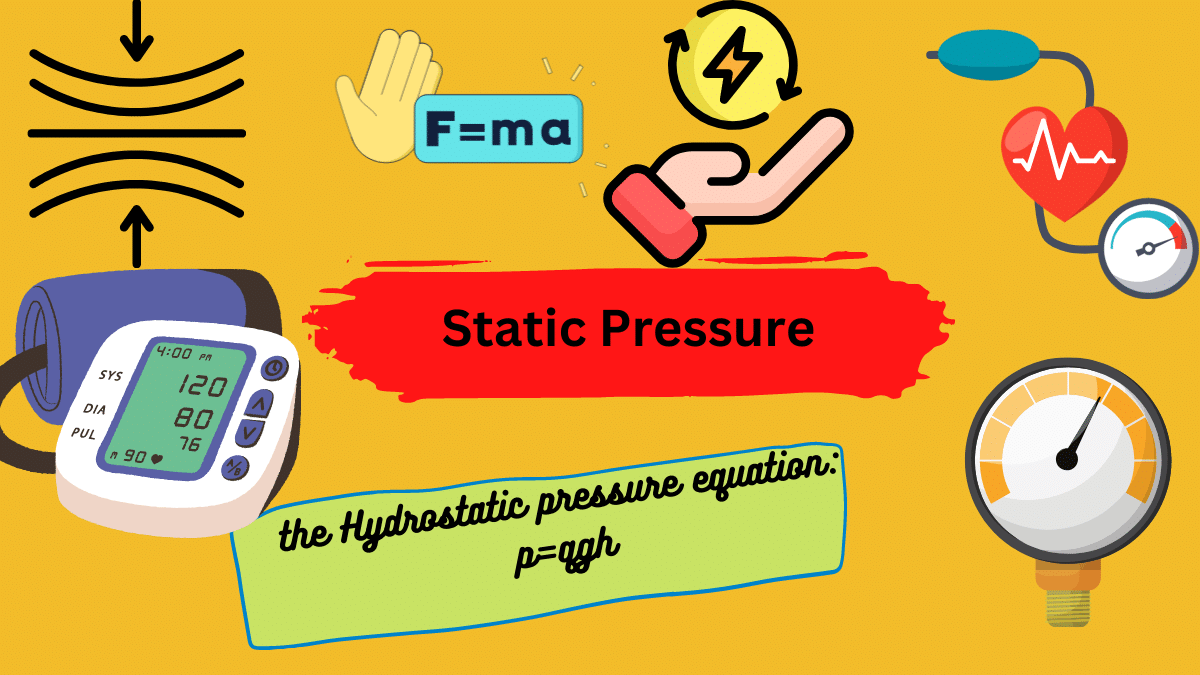Dynamic pressure (sometimes called velocity pressure) refers to the force exerted by a moving fluid, such as air or water, on an object in its path. It is a measure of the impact and energy transferred by the fluid due to its motion. In simpler words, dynamic pressure can be thought of as the “push” or “pressure” that a fluid exerts on an object when it is in motion. The faster the fluid is moving, the higher the dynamic pressure it exerts on the object.
The formula for dynamic pressure (q) is:
q = 0.5 * ρ * v^2
where:
- q represents dynamic pressure,
- ρ (rho) represents the density of the fluid,
- v represents the velocity (speed) of the fluid.
Table of Contents
Daily Life Examples of Dynamic Pressure
- Wind on a Windy Day: When you experience a strong gust of wind on a windy day, you can feel the dynamic pressure exerted by the moving air. The force of the wind pushing against your body or objects around you is an example of dynamic pressure.
- Blowing out Candles: When you blow out candles on a birthday cake, you create a stream of fast-moving air. The dynamic pressure of your breath extinguishes the flame by overpowering the combustion process.
- Opening a Car Window: When you roll down the window of a moving car, you can feel the force exerted on your hand or face due to the air rushing past. The dynamic pressure created by the moving air is what you experience.
- High-Speed Trains Passing By: When a high-speed train passes by, you might feel a strong gust of wind or even get pushed slightly. The dynamic pressure generated by the high-speed train’s movement creates this effect.
- Fluid Flow in Pipes: In plumbing systems, the dynamic pressure is essential for water flow. When you turn on a faucet, the water flows out due to the dynamic pressure generated by the water supply system.
- Jet Engine Thrust: Jet engines work by expelling a high-velocity stream of gases in the opposite direction, creating forward thrust. The dynamic pressure of the exhaust gases plays a crucial role in generating the propulsion force.
Dynamic pressure and Bernoulli’s principle
Generally, pressure refers to the measurement of force applied per unit area on the boundaries of a substance. Dynamic pressure is specifically associated with fluid flow and is connected to Bernoulli’s principle. Bernoulli’s equation describes the relationship between dynamic pressure, fluid velocity, and other factors. The equation is typically stated as:
P + 0.5 * ρ * v^2 + ρ * g * h = constant
Where:
- P represents the static pressure of the fluid
- ρ (rho) represents the density of the fluid
- v represents the velocity of the fluid
- g represents the acceleration due to gravity
- h represents the elevation or height of the fluid above a reference point
This effect causes the lowering of fluid pressure (static pressure) in regions where the flow velocity is increased. This lowering of pressure in a constriction of a flow path may seem counterintuitive but seems less so when you consider the pressure to be energy density. In the high-velocity flow through the constriction, kinetic energy (dynamic pressure – ½.ρ.v2) must increase at the expense of pressure energy (static pressure – p).
As can be seen, dynamic pressure is one of the terms of Bernoulli’s equation. In incompressible fluid dynamics, dynamic pressure is the quantity defined by:
Dynamic Pressure = 0.5 * ρ * v^2
The simplified form of Bernoulli’s equation can be summarized in the following memorable word equation:
Static pressure + dynamic pressure = total pressure (stagnation pressure)
Other types of Pressure
| Type of Pressure | Definition | Formula | Variables | Examples |
| Absolute Pressure | The total pressure exerted by a fluid, including atmospheric pressure as a reference. | P = P₀ + ρgh | P: Pressure, P₀: Atmospheric pressure, ρ: Density of the fluid, g: Acceleration due to gravity, h: Height or depth | Measured tire pressure, barometric pressure, blood pressure measurement. |
| Relative Pressure | The difference between the pressure at a particular point and a reference pressure. | ΔP = P₁ – P₂ | ΔP: Pressure difference, P₁: Pressure at Point 1, P₂: Pressure at Point 2 | Pressure difference between two points in a fluid system, pressure difference across a valve or pump. |
| Differential Pressure | The difference in pressure between two distinct points in a fluid system. | ΔP = P₂ – P₁ | ΔP: Pressure difference, P₁: Pressure at Point 1, P₂: Pressure at Point 2 | Pressure difference across an orifice plate, pressure difference across an air filter, pressure difference across a heat exchanger. |
| Hydrostatic Pressure | The pressure exerted by a fluid due to its weight in a static (non-moving) state. | P = ρgh | P: Pressure, ρ: Density of the fluid, g: Acceleration due to gravity, h: Height or depth | Water pressure in a swimming pool, pressure at the bottom of a water column, pressure at the bottom of a tall tank. |
Summary
- Dynamic pressure is the force exerted by a moving fluid on an object.
- It measures the impact and energy transferred by the fluid due to its motion.
- The formula for dynamic pressure is q = 0.5 * ρ * v^2, where q represents dynamic pressure, ρ represents the fluid density, and v represents the fluid velocity.
- Dynamic pressure increases with higher fluid velocities.
- It is a key factor in aerodynamics, fluid mechanics, and hydraulic systems.
- Dynamic pressure is involved in various daily life scenarios like wind, fluid flow in pipes, and the thrust generated by jet engines.
- Understanding dynamic pressure is important for designing efficient systems and predicting fluid behavior.
More Links
Dynamic Viscosity-Formula Derivation
Reynold’s Number Formula| Daily Life Examples
Reynold’s Number Formula| Daily Life Examples
Graham’s Law – Diffusion and Effusion| Daily Life Examples
Atmospheric Pressure| Definition & Real-Life Examples
Gauge Pressure| Formula, Daily Life Examples and Solved
- BCl3 Lewis Structure in four simple steps - November 1, 2023
- PH3 Lewis Structure in four simple steps - October 8, 2023
- PF3 Lewis structure in four simple steps - September 24, 2023



